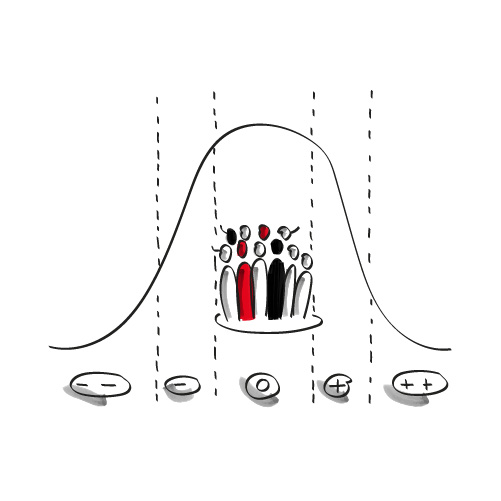Is your business capable of change?
Our world is constantly on the move, so we and our employees must be able to adapt, anticipate and develop. Only thus can we rise to present and future challenges. But are we capable of doing so, and is our business ready for it?
With inspiration from Isaac Newton, I’m going to tell you about the “LP3 Momentum®” formula. It will enable you to calculate the transformation index of your business and set priorities to ensure your long-term future.
In our present circumstances, as we struggle with loss of control, insecurity and new social tensions, it is all the more important to create positive momentum, restore confidence and strengthen personal relationships. The more social distancing is imposed on us, the more isolated and in need of contact, team work, sharing and leadership we feel. To face down our fears, we need to become aware of our new reality and of signs that we are moving in the right direction.
It was in contemplating Newton’s pendulum that it all became clear to me. Everything I had set up, achieved and developed in recent years in support of business transformation and teamwork took on a new meaning. To create a positive dynamic as we face change and undergo transformation, we need to work on – and with – our (internal and external) momentum. (Read also: “Change management”, a misnomer: Rather than “managed”, change needs to be supported).
I therefore took Newton’s formula for momentum: P = m*v
“Isaac Newton (Principia Mathematica): Quantitas motus est mensura ejusdem orta ex velocitate et quantitate materiae conjunctim.“
Momentum (P) is equal to mass (m) times velocity, or speed (v)
When a transformation is required, the transformation index P is equal to mass (degree of people-related inertia) times velocity (degree of agility).
The following explanations are set out in a 6-minute video.
Degree of inertia (m)
Mass, in the context of a business or an organization, is a function of the people involved, the extent of their inertia, which can be represented by a Gauss curve. A number of studies have shown that when plans for change are mooted, for instance the introduction of new products or processes, people are distributed along a Gauss curve, and fall into in five different categories.

People may be:
- (++) very positive, real locomotives, desiring and pushing for the anticipated transformation
- (+) positive, looking forward and actively supporting the process
- (0) middle-of-the-road or neutral, a large body of people, who – if well led – will move in the right direction and adapt
- (-) hesitant, on the defensive
- (–) resolutely opposed, blocking and hindering the process of change.
If you think about your company, you will see that you can fairly easily assign executives, managers and employees to these different categories. You can break them down by giving percentages (%). Once this exercise is done, where do you put the emphasis? Where should the emphasis be placed? Unfortunately, the emphasis is often on the (-) and (–). This takes up a lot of our energy. It does not mean that we should not take them seriously: it is important to listen to the “fears” involved (see the article on courage). However, the emphasis must be on the (+) and (++) to create this positive dynamic. They will create the movement (momentum) and thus get more and more “neutral” (0) collaborators to join.
In gauging this degree of inertia, it is important not only to analyse people’s positions on the curve, but also to see where they place themselves, and this applies to each group (senior executives, managers and employees).
You will see if people’s self-assessments correspond to the way they are perceived by others. I can tell you that, in many cases, you will find there is a “perception gap”.
This gap is due to the difference between what people say and what they actually do: what their decisions, and above all their behaviour, show about them.
So, to create positive momentum, you will have to work on people’s behaviour. A cultural change is impossible without a change in outward behaviour. With this in mind, you will have to define some key behaviour patterns, prioritize them and consistently put them into effect. (Read also: Why don’t we have the impact we would like?)
Where behavioural principles are concerned, here are a few rules to reckon with.
A behavioural principle begins with the word “I”, and contains an active verb and just one activity each time. It tends to be a short sentence: “I take responsibility.” “I listen actively.” “I give constructive feedback.” It must be easy to observe and measure such behaviour patterns.
Degree of agility (v)
I have summarized degree of agility as a combination of six factors which you can mark from 1 to 10 (10 being the top mark = good, all is fine).
The six factors are as follows:
- Exemplary behaviour (being a role model), the attitude of your managers and senior executives. This factor of course applies to all your employees, who should also set a good example. However, the behaviour of your senior executives and managers has greater impact, which is why we are more insistent that they set a good example.
- The system. Is the system conducive to change or does it act as a brake?
Is it coherent and consistent? Above all, does it allow sufficient freedom, or is it very rigid and hierarchical? - “Agile” tools and methods.
In many cases, progressive methods are already in use and the necessary skills are in place. But are they visible? Are good practices communicated, presented, explained? Are the methods concerned up to date?
While on this subject, let me mention some tools and methods that are both interesting and helpful: JIRA, Trello, Gilhub, Google Analytics, Amplitude, Miro, Aha, Clicktale, Google Form, Survey Monkey, Slack, Microsoft Teams, Confluence, Lean, Scrum and Kanban, not to mention Brainstorming and World-café.
A method I both practise and advocate is described in the book “Simplicity” by Michael Hartschen, Jiri Scherrer and Chris Brügger. It sets out five principles and 13 strategies for simplifying processes, products and services. And it ends with instructions on how to run a “simplification workshop”. - Personal autonomy and adaptability.
The fact is that not everyone has the resources and the desire to shoulder responsibilities, take decisions and carry the can for the consequences.
It is important to grow and develop this autonomy, as well as the ability to adapt to changing circumstances. How do things stand in your organization? - Being consistent.
I stress this because it is a very important point. Are the people in your company or organization, at all levels, consistent?
For example, if a new tool is introduced, is the old tool or method discontinued, or does it remain in use?
When a decision is taken, is it acted on across the board and rigorously followed up? - The learning organization. The sixth and final factor takes into account the notions of sharing, cooperation and learning. As far back as 1977, Chris Argyris developed the idea of the learning organization and proposed the principles of learning feedback loops. One of his pupils, Peter Senge, later built on this in his book, “The Fifth Discipline”.
Are these elements systematically encouraged and supported?
And what about the right to make mistakes? (See the article on this topic.)
Thus, having assessed the degree of inertia and the degree of agility of your company or organization, you have the two elements that, multiplied one with the other, give the transformation index. On the one hand, you will see if you need to put a lot more effort into creating positive momentum; on the other, you will discover where exactly your priorities should lie.
To reach this point, be sure to:
- Involve all your employees (they need to feel they are part of the project);
- Be transparent and have a clear channel for communicating information about the anticipated change;
- Be bold in setting priorities, without having too many of them. It is better to define between three and five behavioural principles, and stick to them, than to launch 15 projects at one and the same time;
- Be visible and, above all, be a good role model;
- Have a clear vision, with well-defined intermediate steps. The first of these steps should have a deadline of three months, or at most six, for implementation.
- Finally, once positive results have been achieved, communicate and celebrate them. This will boost the confidence of your employees and show them that, this time, things are different; it’s not just window-dressing.
I wish you every success, and especially that you will be able to create positive momentum in transforming your enterprise or organization.
And, where positive attitudes are concerned, it all begins with you!

